Reflective Report: Clinical Skills Assessment and Drain Tube Removal
VerifiedAdded on 2022/12/26
|7
|1703
|40
Report
AI Summary
This report presents a student's reflective analysis of a clinical skills assessment involving the care of a post-operative patient, specifically focusing on the removal of an active drain tube following bowel resection. The student details the initial nervousness and lack of experience in the acute care setting, as well as the challenges encountered in establishing a therapeutic relationship with the patient who exhibited fear and reluctance. The reflection highlights the importance of therapeutic interaction, hand hygiene, and theoretical knowledge in overcoming these challenges and successfully completing the procedure. The student evaluates the experience, recognizing the significance of each step in wound care and drain removal, and identifies both strengths and weaknesses. The analysis incorporates relevant literature on therapeutic relationships, hand hygiene, and post-surgical wound management. The report concludes with an action plan emphasizing the importance of confidence, continued reflection, and prioritizing therapeutic relationships in future practice. The student also highlights the support received from mentors and senior nurses and their commitment to continuous learning in the nursing profession.
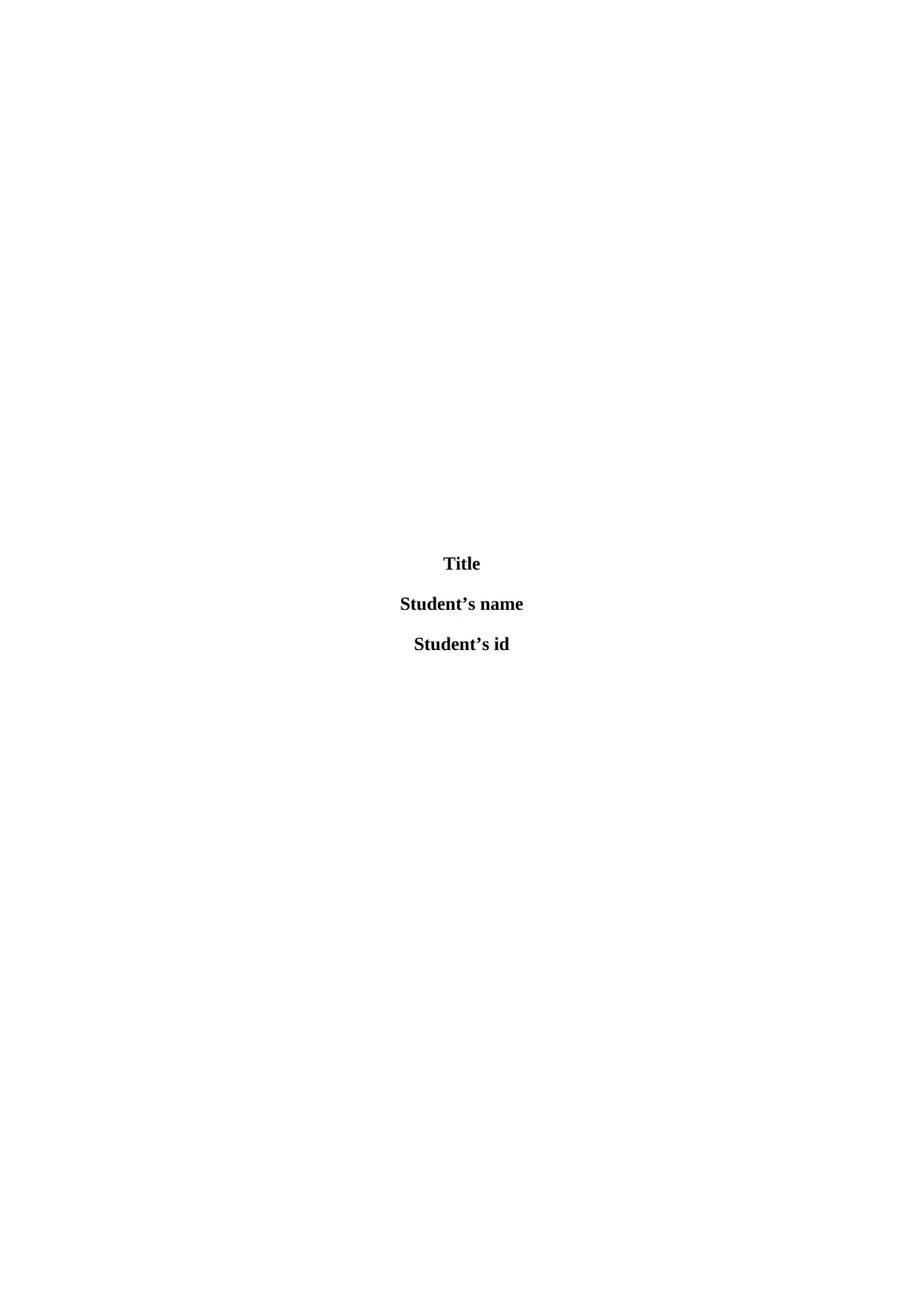
Title
Student’s name
Student’s id
Student’s name
Student’s id
Paraphrase This Document
Need a fresh take? Get an instant paraphrase of this document with our AI Paraphraser
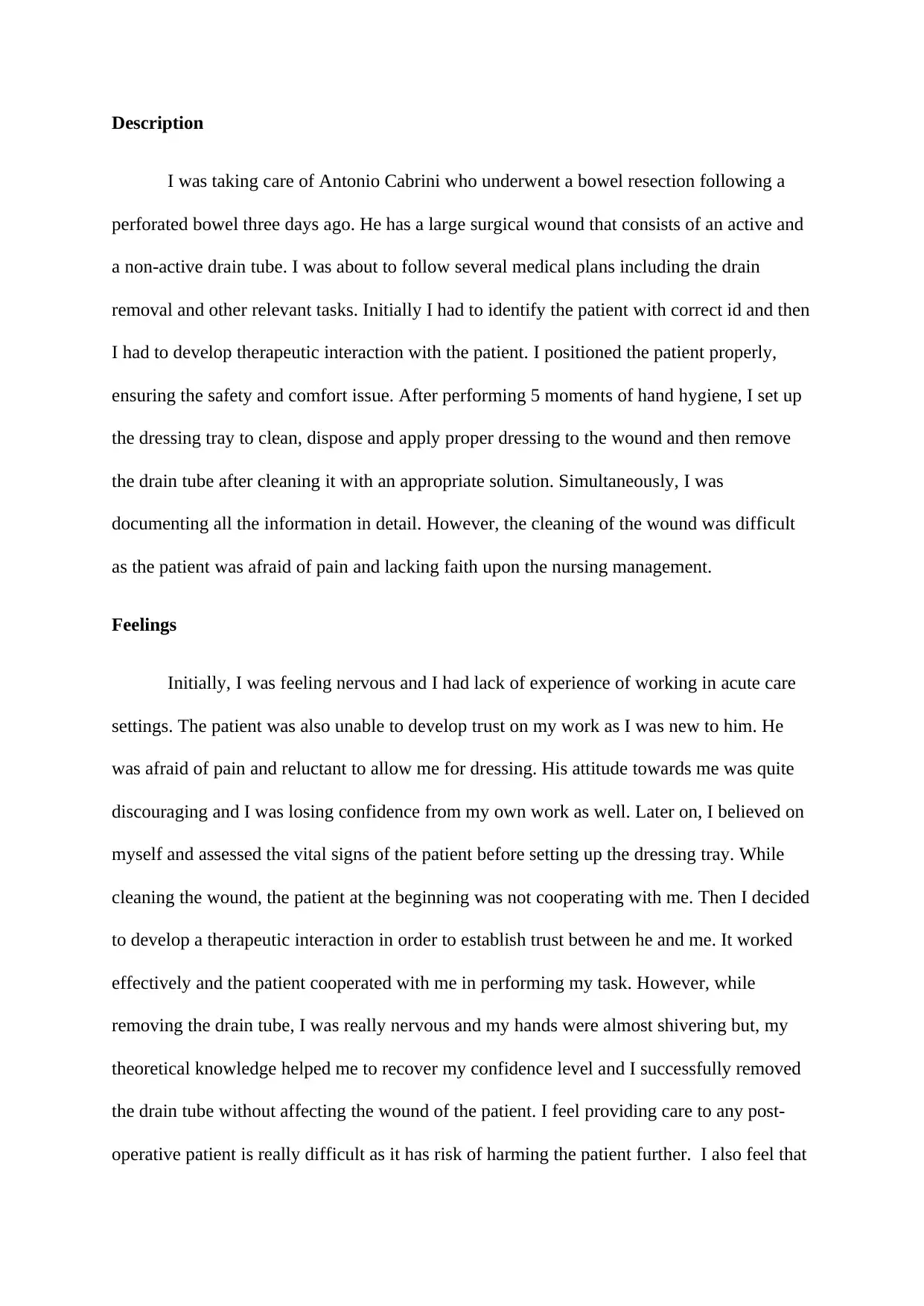
Description
I was taking care of Antonio Cabrini who underwent a bowel resection following a
perforated bowel three days ago. He has a large surgical wound that consists of an active and
a non-active drain tube. I was about to follow several medical plans including the drain
removal and other relevant tasks. Initially I had to identify the patient with correct id and then
I had to develop therapeutic interaction with the patient. I positioned the patient properly,
ensuring the safety and comfort issue. After performing 5 moments of hand hygiene, I set up
the dressing tray to clean, dispose and apply proper dressing to the wound and then remove
the drain tube after cleaning it with an appropriate solution. Simultaneously, I was
documenting all the information in detail. However, the cleaning of the wound was difficult
as the patient was afraid of pain and lacking faith upon the nursing management.
Feelings
Initially, I was feeling nervous and I had lack of experience of working in acute care
settings. The patient was also unable to develop trust on my work as I was new to him. He
was afraid of pain and reluctant to allow me for dressing. His attitude towards me was quite
discouraging and I was losing confidence from my own work as well. Later on, I believed on
myself and assessed the vital signs of the patient before setting up the dressing tray. While
cleaning the wound, the patient at the beginning was not cooperating with me. Then I decided
to develop a therapeutic interaction in order to establish trust between he and me. It worked
effectively and the patient cooperated with me in performing my task. However, while
removing the drain tube, I was really nervous and my hands were almost shivering but, my
theoretical knowledge helped me to recover my confidence level and I successfully removed
the drain tube without affecting the wound of the patient. I feel providing care to any post-
operative patient is really difficult as it has risk of harming the patient further. I also feel that
I was taking care of Antonio Cabrini who underwent a bowel resection following a
perforated bowel three days ago. He has a large surgical wound that consists of an active and
a non-active drain tube. I was about to follow several medical plans including the drain
removal and other relevant tasks. Initially I had to identify the patient with correct id and then
I had to develop therapeutic interaction with the patient. I positioned the patient properly,
ensuring the safety and comfort issue. After performing 5 moments of hand hygiene, I set up
the dressing tray to clean, dispose and apply proper dressing to the wound and then remove
the drain tube after cleaning it with an appropriate solution. Simultaneously, I was
documenting all the information in detail. However, the cleaning of the wound was difficult
as the patient was afraid of pain and lacking faith upon the nursing management.
Feelings
Initially, I was feeling nervous and I had lack of experience of working in acute care
settings. The patient was also unable to develop trust on my work as I was new to him. He
was afraid of pain and reluctant to allow me for dressing. His attitude towards me was quite
discouraging and I was losing confidence from my own work as well. Later on, I believed on
myself and assessed the vital signs of the patient before setting up the dressing tray. While
cleaning the wound, the patient at the beginning was not cooperating with me. Then I decided
to develop a therapeutic interaction in order to establish trust between he and me. It worked
effectively and the patient cooperated with me in performing my task. However, while
removing the drain tube, I was really nervous and my hands were almost shivering but, my
theoretical knowledge helped me to recover my confidence level and I successfully removed
the drain tube without affecting the wound of the patient. I feel providing care to any post-
operative patient is really difficult as it has risk of harming the patient further. I also feel that
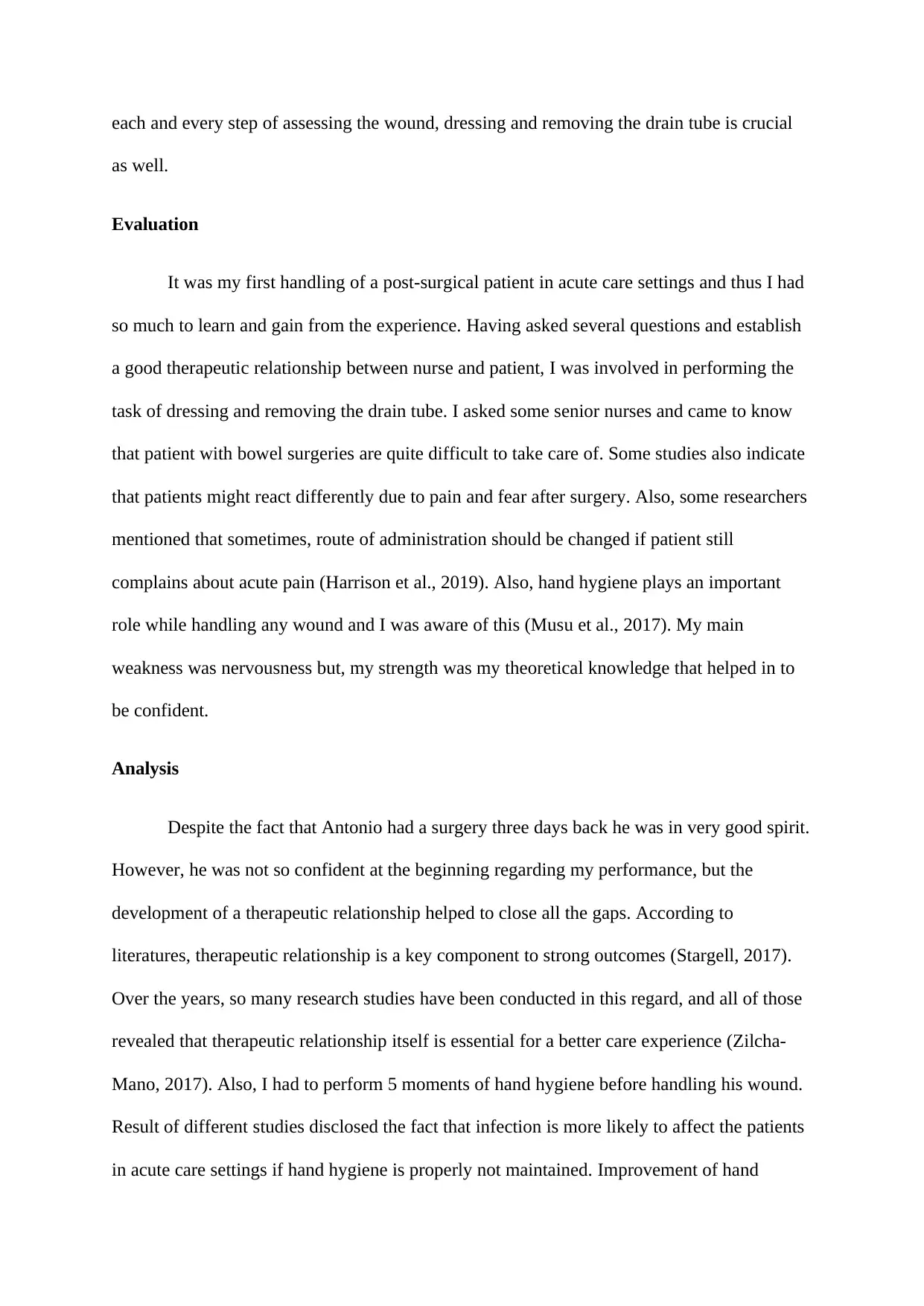
each and every step of assessing the wound, dressing and removing the drain tube is crucial
as well.
Evaluation
It was my first handling of a post-surgical patient in acute care settings and thus I had
so much to learn and gain from the experience. Having asked several questions and establish
a good therapeutic relationship between nurse and patient, I was involved in performing the
task of dressing and removing the drain tube. I asked some senior nurses and came to know
that patient with bowel surgeries are quite difficult to take care of. Some studies also indicate
that patients might react differently due to pain and fear after surgery. Also, some researchers
mentioned that sometimes, route of administration should be changed if patient still
complains about acute pain (Harrison et al., 2019). Also, hand hygiene plays an important
role while handling any wound and I was aware of this (Musu et al., 2017). My main
weakness was nervousness but, my strength was my theoretical knowledge that helped in to
be confident.
Analysis
Despite the fact that Antonio had a surgery three days back he was in very good spirit.
However, he was not so confident at the beginning regarding my performance, but the
development of a therapeutic relationship helped to close all the gaps. According to
literatures, therapeutic relationship is a key component to strong outcomes (Stargell, 2017).
Over the years, so many research studies have been conducted in this regard, and all of those
revealed that therapeutic relationship itself is essential for a better care experience (Zilcha-
Mano, 2017). Also, I had to perform 5 moments of hand hygiene before handling his wound.
Result of different studies disclosed the fact that infection is more likely to affect the patients
in acute care settings if hand hygiene is properly not maintained. Improvement of hand
as well.
Evaluation
It was my first handling of a post-surgical patient in acute care settings and thus I had
so much to learn and gain from the experience. Having asked several questions and establish
a good therapeutic relationship between nurse and patient, I was involved in performing the
task of dressing and removing the drain tube. I asked some senior nurses and came to know
that patient with bowel surgeries are quite difficult to take care of. Some studies also indicate
that patients might react differently due to pain and fear after surgery. Also, some researchers
mentioned that sometimes, route of administration should be changed if patient still
complains about acute pain (Harrison et al., 2019). Also, hand hygiene plays an important
role while handling any wound and I was aware of this (Musu et al., 2017). My main
weakness was nervousness but, my strength was my theoretical knowledge that helped in to
be confident.
Analysis
Despite the fact that Antonio had a surgery three days back he was in very good spirit.
However, he was not so confident at the beginning regarding my performance, but the
development of a therapeutic relationship helped to close all the gaps. According to
literatures, therapeutic relationship is a key component to strong outcomes (Stargell, 2017).
Over the years, so many research studies have been conducted in this regard, and all of those
revealed that therapeutic relationship itself is essential for a better care experience (Zilcha-
Mano, 2017). Also, I had to perform 5 moments of hand hygiene before handling his wound.
Result of different studies disclosed the fact that infection is more likely to affect the patients
in acute care settings if hand hygiene is properly not maintained. Improvement of hand
⊘ This is a preview!⊘
Do you want full access?
Subscribe today to unlock all pages.

Trusted by 1+ million students worldwide
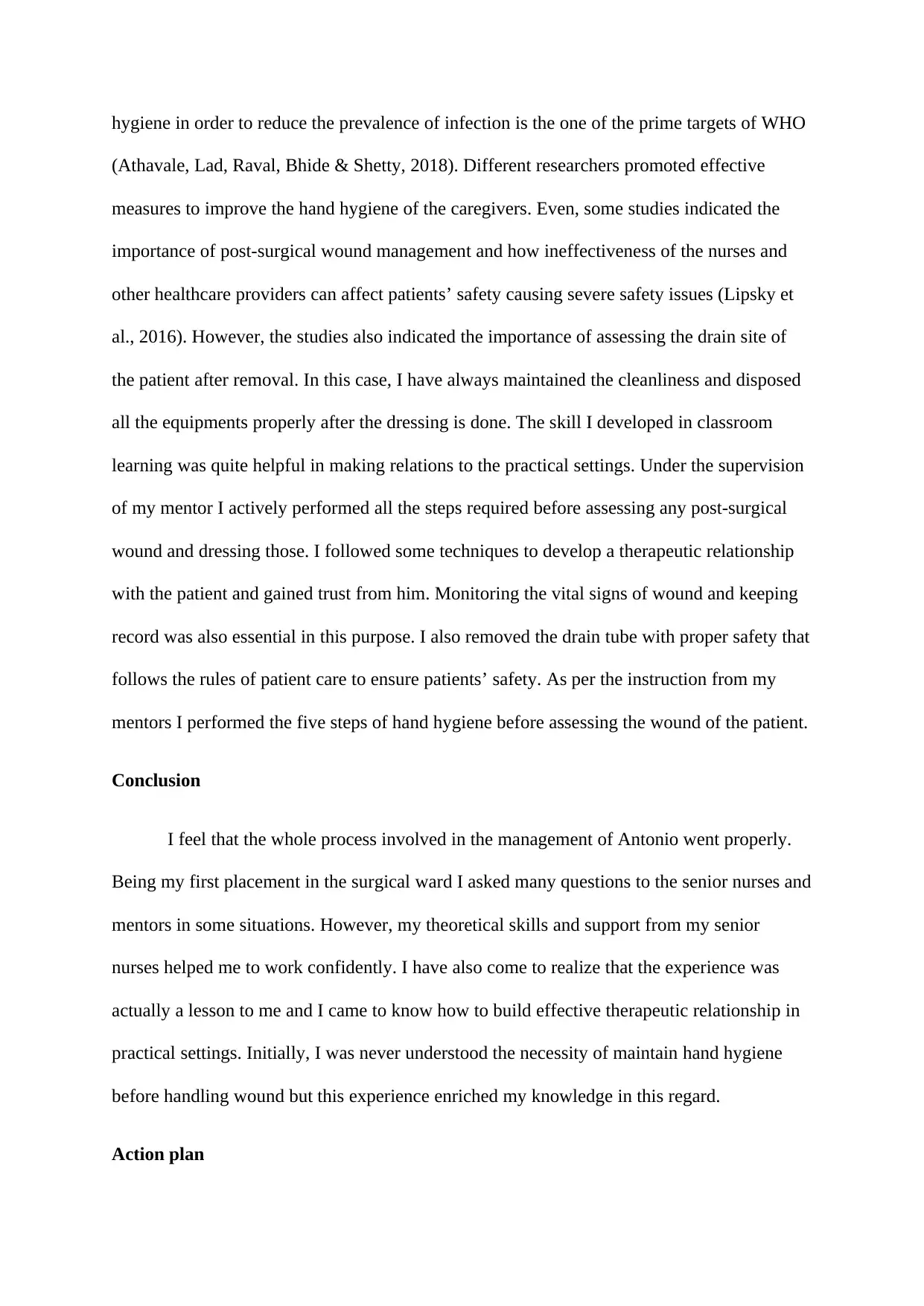
hygiene in order to reduce the prevalence of infection is the one of the prime targets of WHO
(Athavale, Lad, Raval, Bhide & Shetty, 2018). Different researchers promoted effective
measures to improve the hand hygiene of the caregivers. Even, some studies indicated the
importance of post-surgical wound management and how ineffectiveness of the nurses and
other healthcare providers can affect patients’ safety causing severe safety issues (Lipsky et
al., 2016). However, the studies also indicated the importance of assessing the drain site of
the patient after removal. In this case, I have always maintained the cleanliness and disposed
all the equipments properly after the dressing is done. The skill I developed in classroom
learning was quite helpful in making relations to the practical settings. Under the supervision
of my mentor I actively performed all the steps required before assessing any post-surgical
wound and dressing those. I followed some techniques to develop a therapeutic relationship
with the patient and gained trust from him. Monitoring the vital signs of wound and keeping
record was also essential in this purpose. I also removed the drain tube with proper safety that
follows the rules of patient care to ensure patients’ safety. As per the instruction from my
mentors I performed the five steps of hand hygiene before assessing the wound of the patient.
Conclusion
I feel that the whole process involved in the management of Antonio went properly.
Being my first placement in the surgical ward I asked many questions to the senior nurses and
mentors in some situations. However, my theoretical skills and support from my senior
nurses helped me to work confidently. I have also come to realize that the experience was
actually a lesson to me and I came to know how to build effective therapeutic relationship in
practical settings. Initially, I was never understood the necessity of maintain hand hygiene
before handling wound but this experience enriched my knowledge in this regard.
Action plan
(Athavale, Lad, Raval, Bhide & Shetty, 2018). Different researchers promoted effective
measures to improve the hand hygiene of the caregivers. Even, some studies indicated the
importance of post-surgical wound management and how ineffectiveness of the nurses and
other healthcare providers can affect patients’ safety causing severe safety issues (Lipsky et
al., 2016). However, the studies also indicated the importance of assessing the drain site of
the patient after removal. In this case, I have always maintained the cleanliness and disposed
all the equipments properly after the dressing is done. The skill I developed in classroom
learning was quite helpful in making relations to the practical settings. Under the supervision
of my mentor I actively performed all the steps required before assessing any post-surgical
wound and dressing those. I followed some techniques to develop a therapeutic relationship
with the patient and gained trust from him. Monitoring the vital signs of wound and keeping
record was also essential in this purpose. I also removed the drain tube with proper safety that
follows the rules of patient care to ensure patients’ safety. As per the instruction from my
mentors I performed the five steps of hand hygiene before assessing the wound of the patient.
Conclusion
I feel that the whole process involved in the management of Antonio went properly.
Being my first placement in the surgical ward I asked many questions to the senior nurses and
mentors in some situations. However, my theoretical skills and support from my senior
nurses helped me to work confidently. I have also come to realize that the experience was
actually a lesson to me and I came to know how to build effective therapeutic relationship in
practical settings. Initially, I was never understood the necessity of maintain hand hygiene
before handling wound but this experience enriched my knowledge in this regard.
Action plan
Paraphrase This Document
Need a fresh take? Get an instant paraphrase of this document with our AI Paraphraser
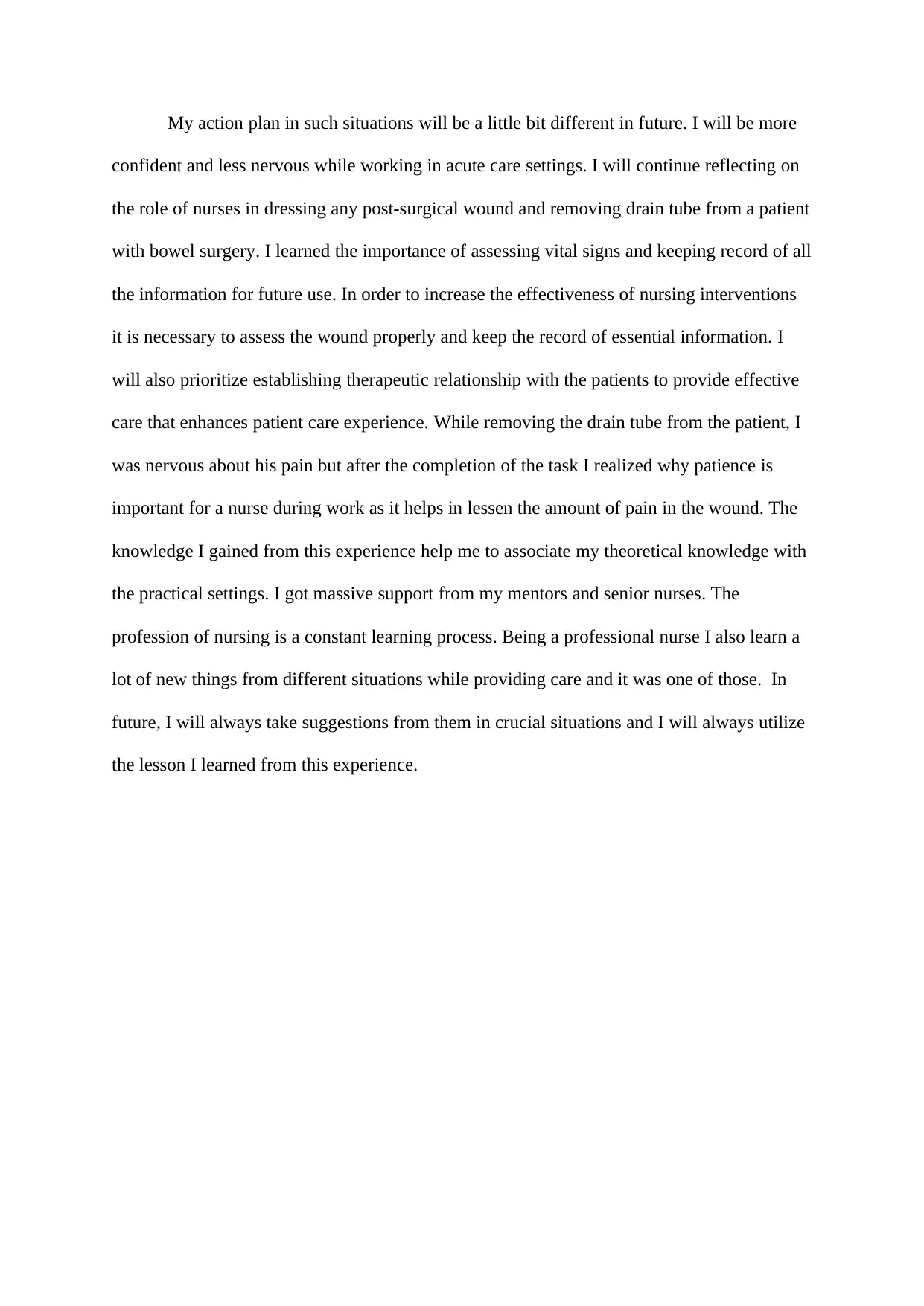
My action plan in such situations will be a little bit different in future. I will be more
confident and less nervous while working in acute care settings. I will continue reflecting on
the role of nurses in dressing any post-surgical wound and removing drain tube from a patient
with bowel surgery. I learned the importance of assessing vital signs and keeping record of all
the information for future use. In order to increase the effectiveness of nursing interventions
it is necessary to assess the wound properly and keep the record of essential information. I
will also prioritize establishing therapeutic relationship with the patients to provide effective
care that enhances patient care experience. While removing the drain tube from the patient, I
was nervous about his pain but after the completion of the task I realized why patience is
important for a nurse during work as it helps in lessen the amount of pain in the wound. The
knowledge I gained from this experience help me to associate my theoretical knowledge with
the practical settings. I got massive support from my mentors and senior nurses. The
profession of nursing is a constant learning process. Being a professional nurse I also learn a
lot of new things from different situations while providing care and it was one of those. In
future, I will always take suggestions from them in crucial situations and I will always utilize
the lesson I learned from this experience.
confident and less nervous while working in acute care settings. I will continue reflecting on
the role of nurses in dressing any post-surgical wound and removing drain tube from a patient
with bowel surgery. I learned the importance of assessing vital signs and keeping record of all
the information for future use. In order to increase the effectiveness of nursing interventions
it is necessary to assess the wound properly and keep the record of essential information. I
will also prioritize establishing therapeutic relationship with the patients to provide effective
care that enhances patient care experience. While removing the drain tube from the patient, I
was nervous about his pain but after the completion of the task I realized why patience is
important for a nurse during work as it helps in lessen the amount of pain in the wound. The
knowledge I gained from this experience help me to associate my theoretical knowledge with
the practical settings. I got massive support from my mentors and senior nurses. The
profession of nursing is a constant learning process. Being a professional nurse I also learn a
lot of new things from different situations while providing care and it was one of those. In
future, I will always take suggestions from them in crucial situations and I will always utilize
the lesson I learned from this experience.
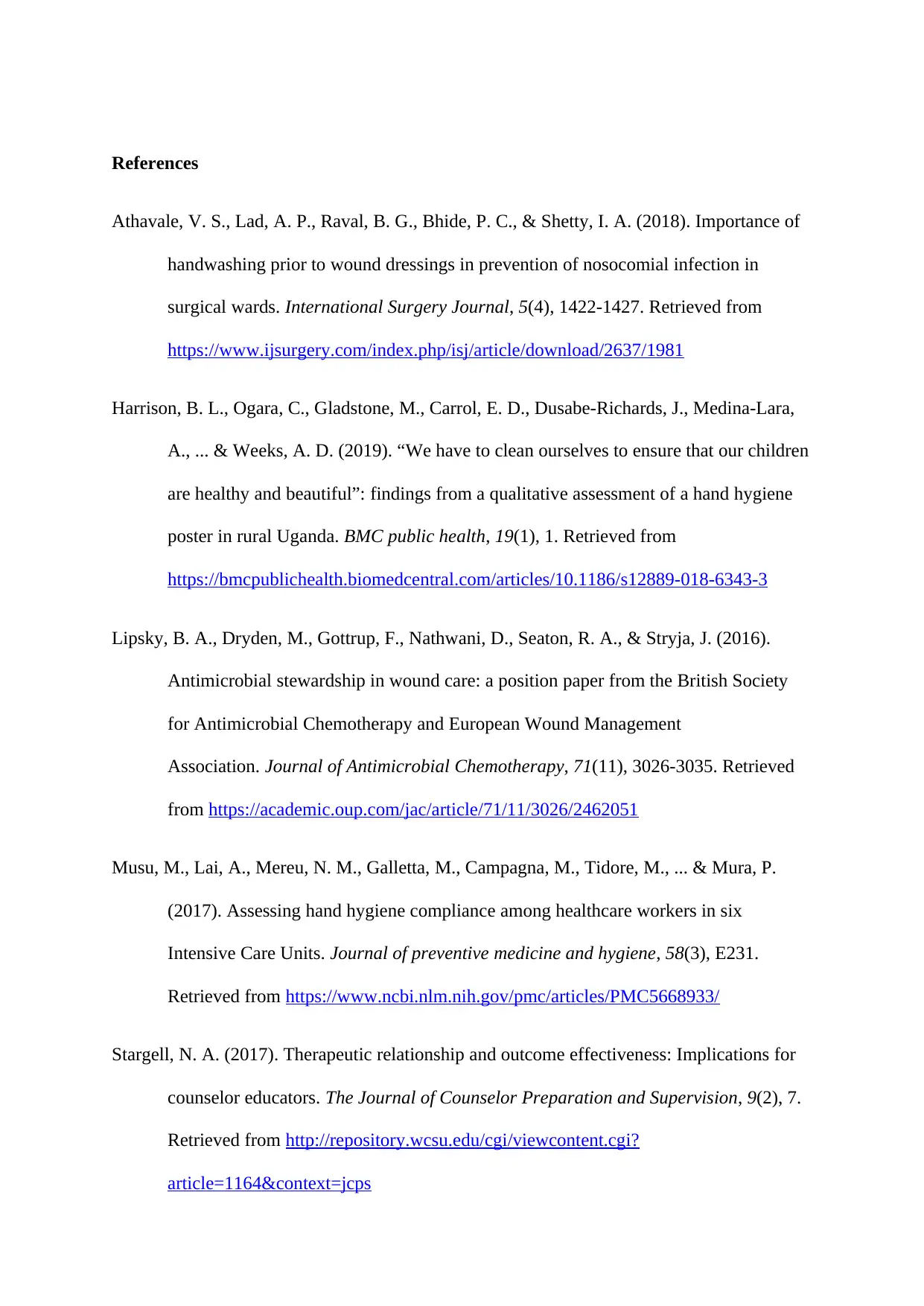
References
Athavale, V. S., Lad, A. P., Raval, B. G., Bhide, P. C., & Shetty, I. A. (2018). Importance of
handwashing prior to wound dressings in prevention of nosocomial infection in
surgical wards. International Surgery Journal, 5(4), 1422-1427. Retrieved from
https://www.ijsurgery.com/index.php/isj/article/download/2637/1981
Harrison, B. L., Ogara, C., Gladstone, M., Carrol, E. D., Dusabe-Richards, J., Medina-Lara,
A., ... & Weeks, A. D. (2019). “We have to clean ourselves to ensure that our children
are healthy and beautiful”: findings from a qualitative assessment of a hand hygiene
poster in rural Uganda. BMC public health, 19(1), 1. Retrieved from
https://bmcpublichealth.biomedcentral.com/articles/10.1186/s12889-018-6343-3
Lipsky, B. A., Dryden, M., Gottrup, F., Nathwani, D., Seaton, R. A., & Stryja, J. (2016).
Antimicrobial stewardship in wound care: a position paper from the British Society
for Antimicrobial Chemotherapy and European Wound Management
Association. Journal of Antimicrobial Chemotherapy, 71(11), 3026-3035. Retrieved
from https://academic.oup.com/jac/article/71/11/3026/2462051
Musu, M., Lai, A., Mereu, N. M., Galletta, M., Campagna, M., Tidore, M., ... & Mura, P.
(2017). Assessing hand hygiene compliance among healthcare workers in six
Intensive Care Units. Journal of preventive medicine and hygiene, 58(3), E231.
Retrieved from https://www.ncbi.nlm.nih.gov/pmc/articles/PMC5668933/
Stargell, N. A. (2017). Therapeutic relationship and outcome effectiveness: Implications for
counselor educators. The Journal of Counselor Preparation and Supervision, 9(2), 7.
Retrieved from http://repository.wcsu.edu/cgi/viewcontent.cgi?
article=1164&context=jcps
Athavale, V. S., Lad, A. P., Raval, B. G., Bhide, P. C., & Shetty, I. A. (2018). Importance of
handwashing prior to wound dressings in prevention of nosocomial infection in
surgical wards. International Surgery Journal, 5(4), 1422-1427. Retrieved from
https://www.ijsurgery.com/index.php/isj/article/download/2637/1981
Harrison, B. L., Ogara, C., Gladstone, M., Carrol, E. D., Dusabe-Richards, J., Medina-Lara,
A., ... & Weeks, A. D. (2019). “We have to clean ourselves to ensure that our children
are healthy and beautiful”: findings from a qualitative assessment of a hand hygiene
poster in rural Uganda. BMC public health, 19(1), 1. Retrieved from
https://bmcpublichealth.biomedcentral.com/articles/10.1186/s12889-018-6343-3
Lipsky, B. A., Dryden, M., Gottrup, F., Nathwani, D., Seaton, R. A., & Stryja, J. (2016).
Antimicrobial stewardship in wound care: a position paper from the British Society
for Antimicrobial Chemotherapy and European Wound Management
Association. Journal of Antimicrobial Chemotherapy, 71(11), 3026-3035. Retrieved
from https://academic.oup.com/jac/article/71/11/3026/2462051
Musu, M., Lai, A., Mereu, N. M., Galletta, M., Campagna, M., Tidore, M., ... & Mura, P.
(2017). Assessing hand hygiene compliance among healthcare workers in six
Intensive Care Units. Journal of preventive medicine and hygiene, 58(3), E231.
Retrieved from https://www.ncbi.nlm.nih.gov/pmc/articles/PMC5668933/
Stargell, N. A. (2017). Therapeutic relationship and outcome effectiveness: Implications for
counselor educators. The Journal of Counselor Preparation and Supervision, 9(2), 7.
Retrieved from http://repository.wcsu.edu/cgi/viewcontent.cgi?
article=1164&context=jcps
⊘ This is a preview!⊘
Do you want full access?
Subscribe today to unlock all pages.

Trusted by 1+ million students worldwide
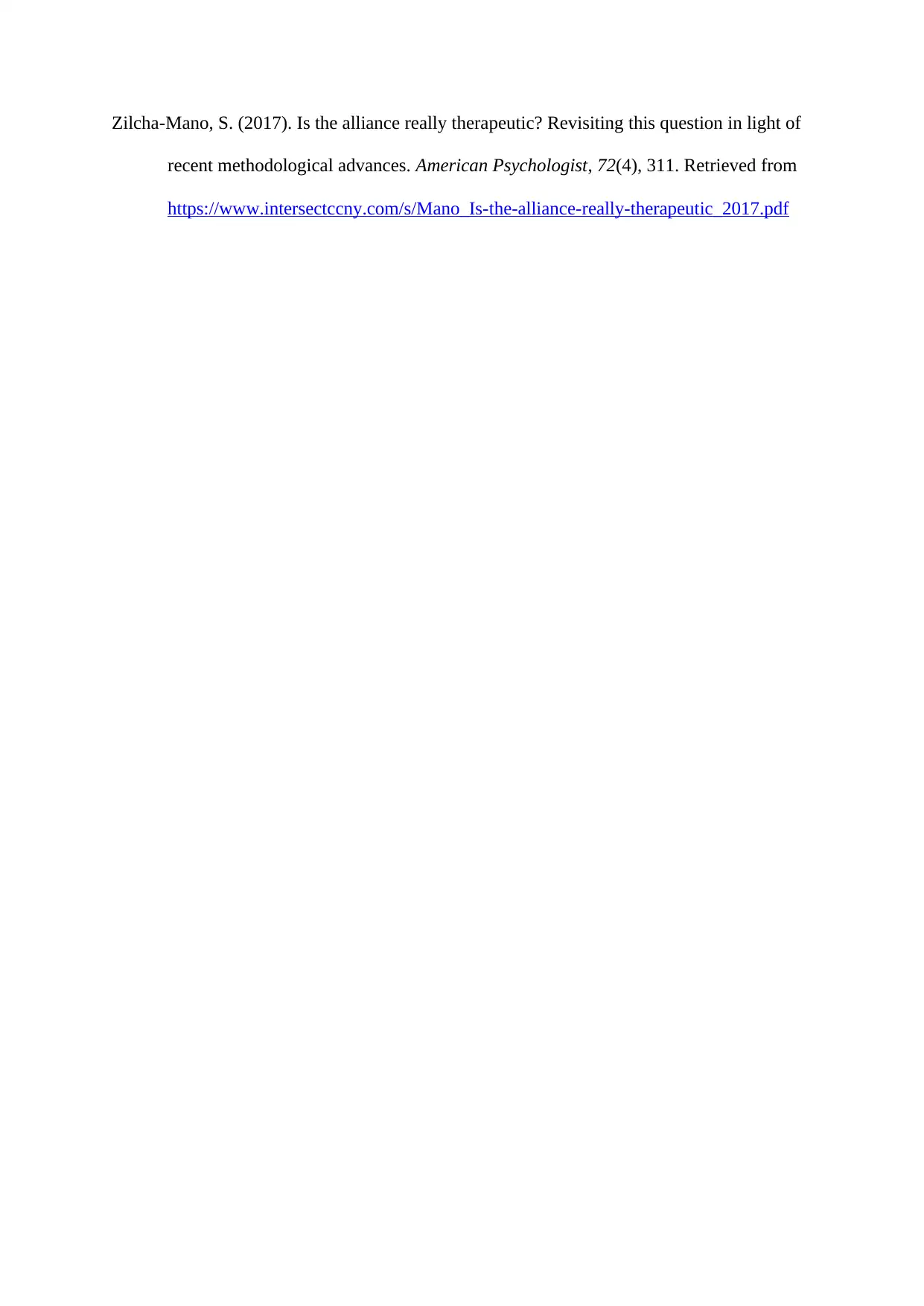
Zilcha-Mano, S. (2017). Is the alliance really therapeutic? Revisiting this question in light of
recent methodological advances. American Psychologist, 72(4), 311. Retrieved from
https://www.intersectccny.com/s/Mano_Is-the-alliance-really-therapeutic_2017.pdf
recent methodological advances. American Psychologist, 72(4), 311. Retrieved from
https://www.intersectccny.com/s/Mano_Is-the-alliance-really-therapeutic_2017.pdf
1 out of 7
Related Documents
Your All-in-One AI-Powered Toolkit for Academic Success.
+13062052269
info@desklib.com
Available 24*7 on WhatsApp / Email
![[object Object]](/_next/static/media/star-bottom.7253800d.svg)
Unlock your academic potential
Copyright © 2020–2025 A2Z Services. All Rights Reserved. Developed and managed by ZUCOL.





